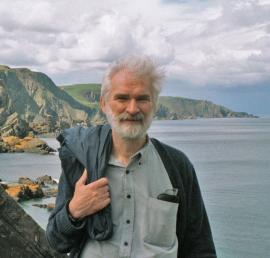Tony Wilkinson Remembrance
Professor Tony Wilkinson, of the Archaeology Department at the University of Durham (UK) passed away on December 25, 2015. He was 66 years old. Tony was widely recognized as one of the world’s leading experts in landscape archaeology, and as the theoretician, methodological innovator, and field archaeologist who revolutionized our understanding of the ancient landscapes of Mesopotamia and the broader Middle East.
Tony was born on August 14, 1948, and grew up in Essex. He trained as a geographer at the University of London- Birkbeck College, and received his Masters Degree at McMaster University (Ontario, Canada), studying the hydrology of overland water flow in the Canadian Arctic. Tony then shifted his focus to archaeology, conducting innovative fieldwork projects of wet and dry landscape archaeology in the UK and across the Middle East in the varied terrains of Oman, Yemen, Saudi Arabia, Iraq, Syria, Turkey and Iran. By combining the methodologies of geography, geomorphology, and archaeology in these projects, Tony was able to develop a nuanced and sophisticated approach to understanding the ways that the interplay of environment and human culture shaped the historical development of landscapes and civilizations in Greater Mesopotamia and surrounding regions. Tony distilled these insights into his book Archaeological Landscapes of the Near East (University of Arizona Press, 2003), a classic synthesis that was honored with the Society for American Archaeology Book Award in 2004, and the James R. Wiseman Book Award of the Archaeological institute of America in 2005.
Tony was the Assistant Director of the British School of Archaeology in Iraq from 1989 to 1992. From 1992 to 2003 he was Research Associate (Associate Professor) at the Oriental Institute of the University of Chicago, where he founded the Center for Ancient Middle Eastern Landscapes (“CAMEL”) in the early 1990’s. At the CAMEL lab, Tony worked with his students to develop the protocols for using the newly declassified CORONA satellite images to map sites and relict ancient landscapes across Upper Mesopotamia. Returning to the UK in 2003, Tony was a Lecturer and then Professor at the University of Edinburgh. In 2006 he took a position as Professor in the Department of Archaeology at the University of Durham, where he taught and conducted research until his passing. At Chicago, Edinburgh and Durham, Tony trained several generations of students, many of whom have gone on to become major figures in their own right in landscape archaeology.
Many of Tony’s most important contributions to landscape archaeology derived from his long term research program exploring the complex inter-relationship of environmental instability, agricultural strategies, and the dynamics of urbanized state societies in the 3rd millennium BC Early Bronze Age of Upper Mesopotamia. These city-states developed in what Tony liked to call the “zone of uncertainty” in the marginal environment on the edge of the rain-fed agriculture region of “Upper Mesopotamia” – the area that encompasses southeast Turkey, North Syria, and the northern Iraqi Jezira. Tony reconstructed the ancient landscapes of Upper Mesopotamian complex societies through a unique synthesis of methodologies that combined the documentation of field scatters of sherds (derived from ancient manuring practices), the mapping of ancient roads and shepherds’ paths (“hollow ways”), intensive archaeological site (and off-site) survey, paleo-environmental reconstruction, satellite imagery, and agent-based computer simulation modeling. The synthetic approach that Tony developed has now become standard practice in Near Eastern landscape archaeology, and is one of his most important legacies. Tony’s intellectual contributions were recognized by his election as a Fellow of the British Academy in 2008, and by his being awarded the John Cole Medal for Landscape Archaeology by the British Academy in 2009.
As a researcher, Tony was especially admirable in always being open to new ideas, and for the way he never lapsed into dogmatism. He was that rare combination of being both a brilliant scholar and a truly nice person. Tony was also known to a fortunate few in his alter ego as a talented Blues harmonica player and onetime member of the Bamboo Beat Band.
Tony is survived by his wife, Eleanor Barbanes Wilkinson. His numerous friends, colleagues, and students will miss him greatly, and we extend our deepest condolences to Eleanor and their family.
- Gil J. Stein, Oriental Institute, University of Chicago, Chicago IL
I gratefully acknowledge the assistance of Eleanor Barbanes Wilkinson, Jason Ur, Mark Altaweel, Chris Gerrard, and McGuire Gibson in the preparation of this remembrance. I also Thank Eleanor Wilkinson for providing me with a copy of Charles French’s 2014 article “Wilkinson, Tony James” in Encyclopedia of Global Archaeology, ed. C. Smith. Copyright Spronger Science and Business Media New York.


